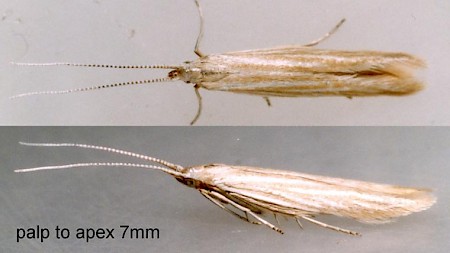37.093 BF559
Coleophora peribenanderi
Toll, 1943
Wingspan 12.5-15 mm.
The larva of this moth forms a case, approximately 11-12 mm long, beneath a thistle (Carduus or Cirsium) leaf, although burdock (Arctium) may sometimes be used. Feeding takes place July - September, and most larvae diapause full fed until pupation in May. Some larvae complete feeding in April. The shape of the ochreous case varies as, when being enlarged, it is elongated first, and the girth increased subsequently.
The adults fly in June and July.
The moth is often common in habitats where its foodplants occur, and is distributed throughout England, Wales and southern Scotland.
Similar species:
Rarely, larvae of Coleophora follicularis have been found on Cirsium arvense. That species also has an ochreous case, but the angle of the oral opening (about 30 degrees to the long axis) is less than that of C. peribenanderi (about 50 degrees), so the normal stance of the C. follicularis case is much more prone. The plate on T1 has a thin dividing line on C. peribenanderi, while C. follicularis lacks an obvious line.
Adults of C. peribenanderi resemble several other Coleophora species. Specimens not reared off its foodplant should be identified by examination of the genitalia aided by MBGBI vol.3.
See also Cirsium key.

 UKMoths
UKMoths 






